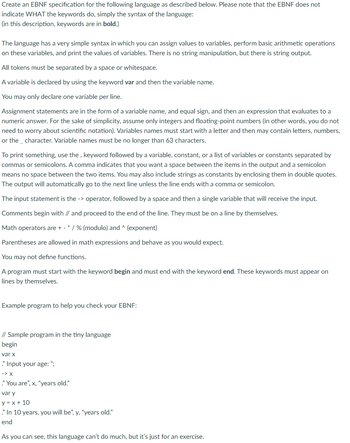
Database System Concepts
7th Edition
ISBN: 9780078022159
Author: Abraham Silberschatz Professor, Henry F. Korth, S. Sudarshan
Publisher: McGraw-Hill Education
expand_more
expand_more
format_list_bulleted
Concept explainers
Question
I would be really thankful if you could help me out with the details. I am really confused about this assignment. And please don't copy other answers to here.

Transcribed Image Text:Create an EBNF specification for the following language as described below. Please note that the EBNF does not
indicate WHAT the keywords do, simply the syntax of the language:
(in this description, keywords are in bold.)
The language has a very simple syntax in which you can assign values to variables, perform basic arithmetic operations
on these variables, and print the values of variables. There is no string manipulation, but there is string output.
All tokens must be separated by a space or whitespace.
A variable is declared by using the keyword var and then the variable name.
You may only declare one variable per line.
Assignment statements are in the form of a variable name, and equal sign, and then an expression that evaluates to a
numeric answer. For the sake of simplicity, assume only integers and floating-point numbers (in other words, you do not
need to worry about scientific notation). Variables names must start with a letter and then may contain letters, numbers,
or the character. Variable names must be no longer than 63 characters.
To print something, use the. keyword followed by a variable, constant, or a list of variables or constants separated by
commas or semicolons. A comma indicates that you want a space between the items in the output and a semicolon
means no space between the two items. You may also include strings as constants by enclosing them in double quotes.
The output will automatically go to the next line unless the line ends with a comma or semicolon.
The input statement is the -> operator, followed by a space and then a single variable that will receive the input.
Comments begin with // and proceed to the end of the line. They must be on a line by themselves.
Math operators are + - * / % (modulo) and ^ (exponent)
Parentheses are allowed in math expressions and behave as you would expect.
You may not define functions.
A program must start with the keyword begin and must end with the keyword end. These keywords must appear on
lines by themselves.
Example program to help you check your EBNF:
// Sample program in the tiny language
begin
var x
." Input your age:";
-> X
." You are", x, "years old."
var y
y = x + 10
." In 10 years, you will be", y, "years old."
end
As you can see, this language can't do much, but it's just for an exercise.
Expert Solution
This question has been solved!
Explore an expertly crafted, step-by-step solution for a thorough understanding of key concepts.
Step by stepSolved in 3 steps

Knowledge Booster
Learn more about
Need a deep-dive on the concept behind this application? Look no further. Learn more about this topic, computer-science and related others by exploring similar questions and additional content below.Similar questions
- Tell me about a moment when you struggled to get your ideas across in an online class or assignment. Do you have any thoughts about how we might solve these issues?arrow_forwardClick to select the general guidelines to improve the quality of documentation text. Here, you have to arrange the options given in the list into their correct order. Guidelines to improve the quality of documentation text Use e‐prime style. Use consistent terms. Use parallel grammatical structures. Use simple language. Use the passive voice. Use friendly language. Sequencing of the selected item is not required. Click to select items.arrow_forwardWrite down the things that are most important to you in your job and explain why they are important.arrow_forward
- Analyze certain items and provide suggestions based on your use experience. It's for an HCI Action project.arrow_forwardThink about the myriad of excuses that someone might potentially come up with to avoid doing the right thing or according to the rules. Both of these responsibilities have become less challenging as a direct result of recent advances in technical capability.arrow_forwardIf you could provide us with a rough idea of the entire quantity of information that goes into making the big picture, that would be much appreciated. Is it possible for a young person to travel the world without running the risk of becoming bankrupt as a consequence of their experiences?arrow_forward
arrow_back_ios
arrow_forward_ios
Recommended textbooks for you
 Database System ConceptsComputer ScienceISBN:9780078022159Author:Abraham Silberschatz Professor, Henry F. Korth, S. SudarshanPublisher:McGraw-Hill Education
Database System ConceptsComputer ScienceISBN:9780078022159Author:Abraham Silberschatz Professor, Henry F. Korth, S. SudarshanPublisher:McGraw-Hill Education Starting Out with Python (4th Edition)Computer ScienceISBN:9780134444321Author:Tony GaddisPublisher:PEARSON
Starting Out with Python (4th Edition)Computer ScienceISBN:9780134444321Author:Tony GaddisPublisher:PEARSON Digital Fundamentals (11th Edition)Computer ScienceISBN:9780132737968Author:Thomas L. FloydPublisher:PEARSON
Digital Fundamentals (11th Edition)Computer ScienceISBN:9780132737968Author:Thomas L. FloydPublisher:PEARSON C How to Program (8th Edition)Computer ScienceISBN:9780133976892Author:Paul J. Deitel, Harvey DeitelPublisher:PEARSON
C How to Program (8th Edition)Computer ScienceISBN:9780133976892Author:Paul J. Deitel, Harvey DeitelPublisher:PEARSON Database Systems: Design, Implementation, & Manag...Computer ScienceISBN:9781337627900Author:Carlos Coronel, Steven MorrisPublisher:Cengage Learning
Database Systems: Design, Implementation, & Manag...Computer ScienceISBN:9781337627900Author:Carlos Coronel, Steven MorrisPublisher:Cengage Learning Programmable Logic ControllersComputer ScienceISBN:9780073373843Author:Frank D. PetruzellaPublisher:McGraw-Hill Education
Programmable Logic ControllersComputer ScienceISBN:9780073373843Author:Frank D. PetruzellaPublisher:McGraw-Hill Education

Database System Concepts
Computer Science
ISBN:9780078022159
Author:Abraham Silberschatz Professor, Henry F. Korth, S. Sudarshan
Publisher:McGraw-Hill Education

Starting Out with Python (4th Edition)
Computer Science
ISBN:9780134444321
Author:Tony Gaddis
Publisher:PEARSON

Digital Fundamentals (11th Edition)
Computer Science
ISBN:9780132737968
Author:Thomas L. Floyd
Publisher:PEARSON

C How to Program (8th Edition)
Computer Science
ISBN:9780133976892
Author:Paul J. Deitel, Harvey Deitel
Publisher:PEARSON

Database Systems: Design, Implementation, & Manag...
Computer Science
ISBN:9781337627900
Author:Carlos Coronel, Steven Morris
Publisher:Cengage Learning

Programmable Logic Controllers
Computer Science
ISBN:9780073373843
Author:Frank D. Petruzella
Publisher:McGraw-Hill Education